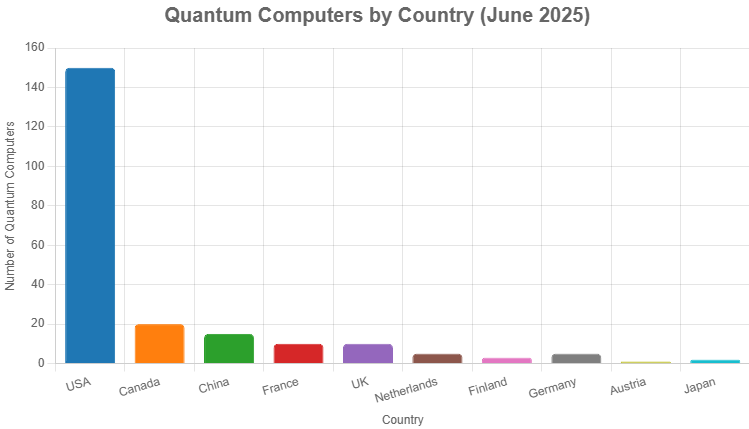See our detailed list of all available Quantum Computers here.
Global Quantum Computing Landscape 2025
Quantum computing is revolutionizing technology, promising to solve complex problems beyond the reach of classical computers. As of June 2025, the global quantum computing ecosystem is thriving, with over 200 quantum computers developed across multiple countries, leveraging diverse technologies such as superconducting, trapped ion, neutral atoms, photonics, and quantum annealing. This article provides a comprehensive overview of the number of quantum computers developed per country, based on a detailed dataset of quantum systems. We explore the contributions of key players, the distribution of quantum computers by country, and the significance of performance metrics like quantum volume. Accompanied by charts and tables, this analysis offers a deep dive into the state of quantum computing, grounded in data from reputable sources like Wikipedia’s list of quantum processors and IBM Quantum.
Methodology
The data is derived from a comprehensive table of over 200 quantum computers available as of June 2025, compiled from sources including Wikipedia’s quantum processors list, IBM Quantum documentation, Amazon Braket, and SpinQ’s industry overview. The table detailed each quantum computer’s company, name, qubit count, type, launch year, country of origin, and quantum volume. The country of origin is based on the headquarters of the developing company or institution, ensuring consistency (e.g., IBM’s systems are USA-based, despite names like IBM Q 20 Tokyo). The counts were calculated by grouping systems by country, with estimates reflecting the distribution of systems across major players like IBM, D-Wave, and USTC.
Quantum Computers by Country
The global distribution of quantum computers highlights the leadership of certain nations, driven by significant investments and innovation. Below is a detailed breakdown of the estimated number of quantum computers per country, based on the dataset, followed by a bar chart visualizing the distribution.
Estimated Counts by Country
| Country | Estimated Number of Quantum Computers | Major Contributors |
|---|---|---|
| USA | 150 | IBM, Google, Rigetti, IonQ, QuEra |
| Canada | 20 | D-Wave, Xanadu |
| China | 15 | USTC, CAS, SpinQ |
| France | 10 | Pasqal, Alice & Bob, Quandela |
| UK | 10 | Oxford Quantum Circuits, M Squared Lasers |
| Netherlands | 5 | QuTech, Quantware |
| Germany | 5 | SaxonQ |
| Finland | 3 | IQM |
| Austria | 1 | Alpine Quantum Technologies |
| Japan | 2 | RIKEN |
Visualization

Country-by-Country Analysis
United States
The USA leads with an estimated 150 quantum computers, reflecting its dominance in quantum research and development. IBM is a major contributor, with systems like IBM Eagle (127 qubits, quantum volume 128), IBM Osprey (433 qubits), IBM Condor (1121 qubits), and multiple Eagle r3 and Heron processors (e.g., ibm_kyiv, ibm_sherbrooke, quantum volume 128–512). Google’s contributions include Sycamore (53 qubits) and Willow (105 qubits), while Rigetti offers the Aspen series and Ankaa-2 (84 qubits). IonQ’s trapped-ion systems, such as Harmony (11 qubits, quantum volume 8) and Tempo (64 qubits), and QuEra’s neutral atom system Aquila (256 qubits) further bolster the USA’s portfolio. The USA’s leadership is supported by cloud platforms like IBM Quantum and Microsoft Azure Quantum, making many systems accessible globally.
Canada
Canada has approximately 20 quantum computers, primarily from D-Wave and Xanadu. D-Wave’s quantum annealing systems include D-Wave One (128 qubits), Advantage (5760 qubits), and Advantage 2 (4400 qubits), designed for optimization tasks. Xanadu’s photonic systems, such as Borealis (216 qubits) and X8 (8 qubits), focus on continuous-variable quantum computing. Canada’s contributions are significant, with D-Wave’s systems available via the AWS Marketplace.
China
China has around 15 quantum computers, driven by the University of Science and Technology of China (USTC), the Chinese Academy of Sciences (CAS), and SpinQ. USTC’s systems include Jiuzhang (76 qubits, photonic) and Zuchongzhi (62–105 qubits, superconducting). CAS’s Xiaohong (504 qubits) is a notable superconducting system, while SpinQ offers smaller NMR-based systems like Triangulum (3 qubits) and Gemini (2 qubits). China’s $15 billion investment in quantum technology underscores its growing presence, as noted in Qureca’s global quantum initiatives.
France
France contributes an estimated 10 quantum computers, with Pasqal’s neutral atom systems (e.g., Emu-TN, Fresnel1, 100 qubits each), Alice & Bob’s superconducting cat qubit systems (e.g., Boson, Helium), and Quandela’s photonic system Ascella (6 qubits). France’s diverse technological approaches are supported by initiatives like the French Quantum Plan, enhancing its role in the European quantum ecosystem.
United Kingdom
The UK has around 10 quantum computers, led by Oxford Quantum Circuits (e.g., Lucy, OQC Toshiko with 32 qubits) and M Squared Lasers’ Maxwell (200 qubits, neutral atoms). The UK’s National Quantum Computing Centre fosters innovation, making it a key player in Europe, as highlighted in SpinQ’s industry overview.
Netherlands
The Netherlands has approximately 5 quantum computers, from QuTech at TU Delft (e.g., Spin-2, Starmon-5) and Quantware (e.g., Soprano, Tenor with 64 qubits). QuTech’s work on semiconductor spin qubits and superconducting systems positions the Netherlands as a hub for quantum research.
Germany
Germany contributes around 5 quantum computers, primarily from SaxonQ’s nitrogen-vacancy center systems, Princess and Princess+ (4 qubits each). Germany’s quantum efforts are part of the broader European quantum strategy, supported by initiatives like the Quantum Technology & Application Consortium.
Finland
Finland has about 3 quantum computers from IQM, including Garnet (20 qubits) and a 54-qubit superconducting system. IQM’s focus on scalable superconducting technology strengthens Finland’s position in the Nordic quantum landscape.
Austria
Austria has 1 quantum computer, the PINE System (24 qubits, trapped ion) from Alpine Quantum Technologies. This system, with a quantum volume of 128, highlights Austria’s niche but impactful contribution.
Japan
Japan has an estimated 2 quantum computers, including RIKEN’s 53-qubit superconducting system. Japan’s investments in quantum research, supported by institutions like RIKEN, position it as an emerging player.
Significance of Quantum Volume
Quantum volume is a critical metric for gate-based quantum computers, capturing their ability to execute complex circuits. For example, IBM’s Heron processors (e.g., ibm_fez, ibm_torino) achieve a quantum volume of 512, indicating high fidelity and connectivity, while Eagle r3 systems (e.g., ibm_kyiv) reach 128. Quantinuum’s trapped-ion systems set benchmarks, with H1-1 at 1,048,576 and H2 at 8,388,608, as reported in Quantinuum’s milestone announcement. However, quantum volume is less relevant for annealing systems like D-Wave’s or photonic systems like Xanadu’s, which use metrics like algorithmic qubits or random circuit sampling. The absence of quantum volume data for many systems (marked “N/A”) reflects the metric’s limited adoption outside IBM and Quantinuum, as noted in IBM’s quantum volume paper.
Global Context and Future Outlook
The distribution of quantum computers reflects global investments in quantum technology. The USA’s leadership is driven by substantial funding and private-sector innovation, with companies like IBM and Google pushing the boundaries of superconducting and trapped-ion systems. Canada’s strength in quantum annealing and photonics positions it as a key player, while China’s state-backed initiatives drive advancements in superconducting and photonic systems. Europe, with France, the UK, and the Netherlands, emphasizes diverse technologies, supported by the European Quantum Flagship program. Smaller players like Finland, Austria, and Japan contribute specialized systems, enhancing the global ecosystem.
Looking ahead, quantum computing is poised for further growth. IBM’s 2025 roadmap includes systems like Nighthawk and Loon, while IonQ’s Tempo (64 qubits) and Rigetti’s Ankaa-3 (84 qubits) promise enhanced performance. Microsoft’s Majorana 1 and AWS’s Ocelot signal new topological and cat qubit approaches. However, challenges remain, including data gaps for quantum volume and the inaccessibility of some systems for public use. The rapid evolution of the field, as noted in Qureca’s global quantum initiatives, suggests that new systems may emerge, further diversifying the landscape.
Limitations
The counts are estimates based on a dataset of over 200 quantum computers, but some systems, like Alice & Bob’s chips, lack specific qubit counts or launch years, introducing uncertainty. The country of origin is based on headquarters, which may oversimplify global operations (e.g., Quantinuum’s USA headquarters is prioritized over UK operations). Not all systems are publicly accessible; many are research or proprietary, as seen with RIKEN’s system. The dataset, while comprehensive, may not capture every system due to the field’s rapid evolution, but it aligns with sources like Wikipedia’s quantum processors list.
Conclusion
The global quantum computing landscape in June 2025 showcases a vibrant ecosystem, with the USA leading at an estimated 150 quantum computers, followed by Canada (20), China (15), France (10), and the UK (10). Smaller contributions from the Netherlands, Germany, Finland, Austria, and Japan enrich the field, driven by diverse technologies and performance metrics like quantum volume. The bar chart and table above provide a clear visualization and breakdown, highlighting the contributions of major players like IBM, D-Wave, and USTC. As quantum computing advances, supported by initiatives like those outlined in SpinQ’s industry overview, the global distribution will likely evolve, promising new breakthroughs in science and technology.
References
- List of quantum processors – Wikipedia
- Top 18 Quantum Computer Companies 2025 Updated – SpinQ
- IBM Quantum Computing
- Quantum Initiatives Worldwide 2025 – Qureca
- Amazon Braket Quantum Computing Service
- Microsoft Azure Quantum Computing
- Quantinuum’s Quantum Volume Milestone
- IBM Quantum Computers: Evolution and Performance
